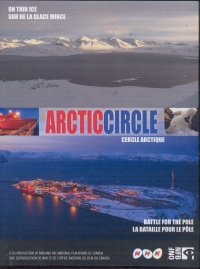| ________________
CM . . .
. Volume XVIII Number 9. . . .October 28, 2011 
 |
Arctic Circle = Cercle Arctique.
Takashi Shibasaki & Atsushi Nishida (NHK Directors). Wally Longui (NFB Director). Wally Longui (Producer). Cindy Witten (NFB Executive Producer). Toshiro Matsumoto (NHK Executive Producer).
Montreal, PQ: National Film Board of Canada, 2009.
2 X 40 min., DVD, $99.95.
Order Number: 153C 9910 068.
Subject Headings:
Climactic changes-Arctic regions.
Sea ice-Arctic regions.
Global warming.
Grades 7 and up / Ages 12 and up.
Review by Barbara McMillan.
**** /4
|
| |
|

excerpt:
The rapid retreat of the Arctic ice pack could be reaching the point of no return, ensuring the polar bears fate. And the bears are the canary in the coal mine for us. Global warming in the Arctic is causing the kind of changes that once unfolded over millennia to take place in little over a century… The plight of Arctic wildlife in the face of radical environmental change is Chapter 1 for the rest of the planet. It's a warning to ourselves: act now before it's too late for us. (From "On Thin Ice," Episode 1 of Arctic Circle.)
Protected by its harsh climate, the Arctic was too hostile to support large-scale development. Global warming has changed that fast. And changes to the rest of our planet may come even faster. Increasing development in the Arctic comes at a price, a vicious circle in which the development enabled by climate change will likely drive further climate change. The more oil, the more heat. The more heat, the less ice. The less ice, the less life. The chain reaction has started. Unless it can be reversed, we just don't know how it will end. (From "Battle for the Pole," Episode 2 of Arctic Circle.)
Directors Takashi Shibasaki and Atsushi Nishida of NHK Japan and Wally Longul of the National Film Board of Canada have collaborated to create Arctic Circle, a disquieting two-part documentary. Episode 1, "On Thin Ice," focuses on the research and changes observed and measured by scientists who have been studying the polar bears on Norway's Svalbard Islands, the calving of Greenland's massive Jacobshavn glacier, the seals and zooplankton in Kings Bay, Spitsbergen, the ice at the North Pole, and air patterns and sea currents in the Arctic Ocean and Fram Strait. Episode 2, "Battle for the Pole," shifts the focus from the impact of climate change on the fragile Arctic ecosystem to the race to claim the untapped reserves of oil and natural gas that the shrinking polar ice cap and technological developments have made accessible. The contrast between those portrayed in each episode could not be more pronounced.
One similarity that does emerge, however, is the scale of the numerical quantities described. For example, the Statoil Norwegian Petroleum Company spent almost ten billion dollars to build a natural gas liquidification plant that cools the gas from the Snovit Gas Field to -163° Celsius before storing it for future shipment. The Snovit Gas Field is believed to hold 25% of the world's undiscovered supplies of oil and gas. The Shtokman Gas Field, also in the Barents Sea, however, is believed to hold a greater amount of natural gas: 3.8 trillion cubic meters. Viewers are told this is enough natural gas to meet Canada's needs at current consumption rates for thirty years. From studies carried out by glaciologists, viewers learn that the Jacobshavn glacier is the world's fastest moving glacier, travelling 35 metres per day. It has doubled its speed in recent years and retreated inland 10 kilometres in the past five years. Each day, 100 million tons of ice calve off this glacier. These slabs of ice are the size of skyscrapers. In a year. this equates to 150 gigatons, which is double the entire volume of all the glaciers in the Alps. According to Dr. Konrad Steffan who studies the giant holes created in ancient glacial ice by rapidly flowing surface water (melting), it is this water that accelerates calving. He is recorded as saying, "A natural process that should take years is taking weeks." It is estimated that, if all the ice in Greenland melts, the sea level will rise six metres.
Both "On Thin Ice" and "Battle for the Pole" generate more questions than answers. Students who have the opportunity to watch this film, which presents information objectively, will certainly raise many more questions. Given the clusters in science curricula developed from the Pan-Canadian Science Framework, a very good fit is Grade 7. This is where students learn about the components of ecosystems, ecological pyramids, and the consequence of human interventions in ecosystems as well as Earth's crust, geological processes, and resource location, extraction, and processing. It is also recommended for social studies teachers interested in global sustainability and the social-political questions this generates.
Karen Feiertaj narrates Arctic Circle, which has both English and French tracks. Each episode is 40 minutes long. The imagery of the Arctic landscape, whether populated and built upon or barren, is breathtaking. Be forewarned: several of the polar bear scenes show Nature in the raw. There are male bears fighting, bears hunting and eating their prey, and bears that have died of starvation.
Highly Recommended.
Barbara McMillan is a teacher educator and a professor of science education in the Faculty of Education, the University of Manitoba.

To comment
on this title or this review, send mail to cm@umanitoba.ca.
Copyright © the Manitoba Library Association. Reproduction for personal
use is permitted only if this copyright notice is maintained. Any
other reproduction is prohibited without permission.
NEXT REVIEW |
TABLE OF CONTENTS FOR THIS ISSUE
- October 28, 2011.
AUTHORS |
TITLES |
MEDIA REVIEWS |
PROFILES |
BACK ISSUES |
SEARCH |
CMARCHIVE |
HOME |
